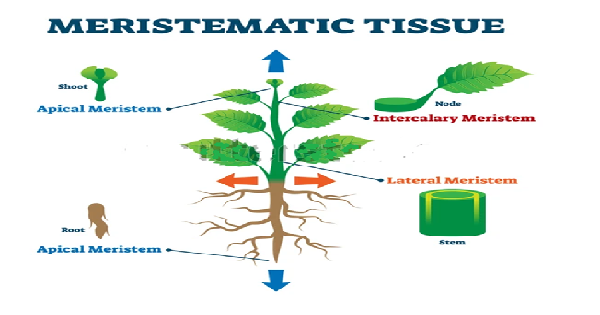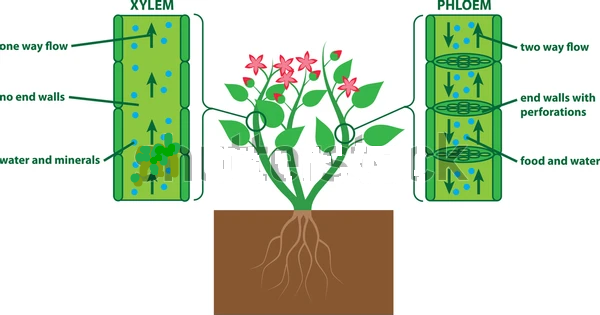Types of plant tissues: Class 9 CBSE Notes
In multicellular organisms there are millions of cells, most of these cells are specialized to carry out specific functions. Each specialized function is taken up by a different group of cells, in-plant, vascular tissues conduct food and water from one part of the plant to other parts of the plant. So, multicellular organisms show division of labour. Cells specializing in one function are often grouped together in the body. This means that a particular function is carried out by a cluster of cells at a definite place in the body. This cluster of cells called a tissue is arranged and designed so as to give the highest possible efficiency of function.A group of cells that are similar in structure and /or work together to achieve a particular function forms a tissue.
Plant Tissues: Plants are stationary or fixed, they don’t move. Since they have to be upright, they have a large quantity of supportive tissue. The supportive tissue has generally dead cells.
The growth in plants is limited in certain areas. There are some tissues in plants that divide throughout their life. These tissues are localized in certain regions, based on the dividing capacity of the tissues, various plant tissues can be classified as growing or meristematic tissue and permanent tissue.
Click for online shopping
Future Study Point.Deal: Cloths, Laptops, Computers, Mobiles, Shoes etc
You can also study NCERT solutions of class 9 chapter 6-Tissues
NCERT solutions of class 9 science chapter 6-Tissues
Class 9 CBSE Science Notes
Three Laws of Motion: Class 9 CBSE
Evoporation,Vapourization and Latent heat -Class 9 CBSE notes
What is an atom,molecule and atomicity of a substance?
How to determine Valency,net charge of an ion and Molecular formula of a substance.
Thrust and Pressure : Difference
The Complete Detail of Archimedes Principal
Average Speed and Average Velocity: Differences
How to evaluate recoil velocity of gun
If energy is conserved then why do we need to save it for future generations?
Molar mass,molecular mass and mole concept
What is second law of of motion ?
What is universal law of gravitational force
Important Science Notes for Class 9 and 10 grade
Class 10 CBSE Science Notes
Class 10 Biology Viva Voce Questions and Answers for CBSE Board 2020-21
Class 10 chemistry Viva Voce Questions and Answers
Class 10 Physics Viva Voce Questions and Answers
Class 10 Chemistry Practical Based Questions and Answers
What are the physical and chemical properties of metals?
Type of Chemical Reactions with Complete detail
Chemical properties of Acids and Bases-A note for grade 10 students
What is pH value and its importance in everyday life.
Ozone Layer and How it is Getting depleted.
Human eye structure and its function
Electrical resistance and conductance
Electric Current and Heating effect of Electric Current
What is a potential difference across an electric field ?
Myopia, Hypermetropia and Presbyopia
Difference between soaps and detergents
Why do the star twinkle but planets don’t
Light reflection, refraction, scattering, and dispersion
Extraction of metals as per the activity series
Ionic and covalent compounds and the difference between them
Food chain and food web in an ecosystem
Types of plant tissues: Class 9 CBSE Notes
Plant Tissues
Plant tissues are of two types,1 -Non-permanent (Meristematic) 2- Permanent.
Meristematic Tissue
The growth of plants occurs only in certain specific regions. This is because the dividing tissue, also known as meristematic tissue, is located only at these points. Depending on the region where they are present, meristematic tissues are classified as apical, lateral, and intercalary. New cells produced by meristem are initially like those of meristem itself, but as they grow and mature, their characteristics slowly change and they become differentiated as components of other tissues.
Apical Meristem: Apical meristem is present at the growing tips of stems and roots and increases the length of the stem and the root.
Lateral Meristem: Lateral meristem is located at the lateral side of the root and stem, its cell division causes to increase the girth or thickness of the stem or root
Intercalary Meristem: The intercalary meristem seen in some plants is located near the node (base of leaves or branch) and internodes, its cell division causes to increase in the length of internodes.
Cells of Meristematic tissue are very active, they have dense cytoplasm, thin cellulose walls, and prominent nuclei. They lack vacuoles.
Please follow us on Pinterest
Permanent Tissue
Depending on the age of plants, the meristematic tissue takes up a specific role and lose the ability to divide due to biological and physiological reason and converted into permanent tissue. This process of taking a permanent shape, size, and function is called differentiation. The specific role of permanent tissues is the conduction of water, nutrients, minerals and provide support and protection to the plants, the cells of permanent tissue may be dead or living. Differentiation leads to the development of various types of permanent tissues. Permanent tissues are of two types (i) Simple permanent tissues (ii) Complex permanent tissues.
(i) Simple Permanent Tissues:
These tissues are simple because they are made of one type of cell that makes the tissue similar in structure. Simple permanent tissues are classified into three types (i) Parenchyma (ii) Cholenchyma (iii) Scalaranchyma
(i) Parenchyma: It consists of relatively unspecialized cells with a thin cell wall. They are living cells and have large intercellular space. This tissue generally stores food..Parenchyma is further classified into two types (i) Chlorenchyma (ii) Aerenchyma
Chlorenchyma: The parenchyma that contains chlorophyll and performs photosynthesis known as chlorenchyma.
(ii) Aerenchyma: Some of the parenchyma due to adaptation develops large air cavities inside them which help the aquatic plants to float on the surface of the water, such a type of parenchyma is known as aerenchyma.
(ii) Cholenchyma: The flexibility in plants is due to another permanent tissue, collenchyma, which allows the bending of various types of plant-like tendrils and stems of climbers without breaking. It provides mechanical support to the plants. It is found in the leaf stalk below the epidermis. The cells of the tissue are living and irregularly thickened at the corners. There is very little intercellular space
(iii) Scalaranchyma: It is the type of parenchyma which makes plant hard and stiff. As an example husk of the coconut is made of sclerenchyma. The cells of this tissue are dead. They are long and narrow and the cell wall is so thickened due to lignin that there is no internal space inside the cell. This tissue is present in stems, around vascular bundles, in the veins of the leaves, and with a hard covering of seeds and nuts. It provides strength to the parts of the plant.
Epidermis
The outermost covering of all the parts of plant stem,branches,leaves ,seeds and fruits that protect the plant is known as epidermis tissue.The epidermis is made of a single layer of the cell, the epidermis of the desert plants is thicker for protecting against water loss . Epidermal cells on the aerial parts of the plants often secrete a waxy, water-resistant layer on their outer surface. This aids in protection against loss of water, mechanical injury, and invasion by parasite fungi. There are small pores in the epidermis of the leaf, these pores are called stomata. Transpiration and the exchange of gases takes place through stomata. Epidermis cells of roots, commonly bear long hair-like parts that greatly increase the total absorptive surface area for maximum absorption of water.In desert plants epidermis has a thick waxy coating of cutin,it is a chemical with waterproof quality and thus prevents water loss.
Cork: As plants grow older, the outer protective tissue undergoes certain changes.A strip of secondary meristem located in the cortex forms layer of cells which constitute cork. Cells of cork are dead and compactly arranged without intercellular spaces. They also have a substance called suberin in their walls that makes them impervious to gases and water.
Complex Permanent Tissues
Complex tissues are made of more than one type of cell. All these cells coordinate to perform a common function. Xylem and phloem are examples of complex issues. They are both conducting tissues and constitute a vascular bundle. The vascular bundle is a distinctive feature of the complex plants that fit the plant to survive in the terrestrial environment.
Xylem: Xylem consists of tracheids, vessels, xylem parenchyma, and xylem fibers. Tracheids and vessels have a thick wall and many are dead cells when mature. Tracheids and vessels are tubular structures. This allows them to transport water and minerals vertically. The parenchyma stores food. Xylem fibers are mainly supportive in function.
Phloem: Phloem is made up of five types of cells, sieve tubes, companion cells, phloem fibers, and the phloem parenchyma. Sieve tubes are tubular cells with perforated walls. Phloem transports food from leaves to other parts of the plants. Except for phloem fibers rest of the cells are living cells.
NCERT Solutions of Science and Maths for Class 9,10,11 and 12
NCERT Solutions for class 9 maths
NCERT Solutions for class 9 science
NCERT Solutions for class 10 maths
CBSE Class 10-Question paper of maths 2021 with solutions
CBSE Class 10-Half yearly question paper of maths 2020 with solutions
CBSE Class 10 -Question paper of maths 2020 with solutions
CBSE Class 10-Question paper of maths 2019 with solutions
NCERT Solutions for Class 10 Science
NCERT Solutions for class 11 maths
| Chapter 1-Sets | Chapter 9-Sequences and Series |
| Chapter 2- Relations and functions | Chapter 10- Straight Lines |
| Chapter 3- Trigonometry | Chapter 11-Conic Sections |
| Chapter 4-Principle of mathematical induction | Chapter 12-Introduction to three Dimensional Geometry |
| Chapter 5-Complex numbers | Chapter 13- Limits and Derivatives |
| Chapter 6- Linear Inequalities | Chapter 14-Mathematical Reasoning |
| Chapter 7- Permutations and Combinations | Chapter 15- Statistics |
| Chapter 8- Binomial Theorem | Chapter 16- Probability |
CBSE Class 11-Question paper of maths 2015
CBSE Class 11 – Second unit test of maths 2021 with solutions
NCERT solutions for class 12 maths
| Chapter 1-Relations and Functions | Chapter 9-Differential Equations |
| Chapter 2-Inverse Trigonometric Functions | Chapter 10-Vector Algebra |
| Chapter 3-Matrices | Chapter 11 – Three Dimensional Geometry |
| Chapter 4-Determinants | Chapter 12-Linear Programming |
| Chapter 5- Continuity and Differentiability | Chapter 13-Probability |
| Chapter 6- Application of Derivation | CBSE Class 12- Question paper of maths 2021 with solutions |
| Chapter 7- Integrals | |
| Chapter 8-Application of Integrals |
Class 12 Solutions of Maths Latest Sample Paper Published by CBSE for 2021-22 Term 2
Class 12 Maths Important Questions-Application of Integrals
Solutions of Class 12 Maths Question Paper of Preboard -2 Exam Term-2 CBSE Board 2021-22
Solutions of class 12 maths question paper 2021 preboard exam CBSE Solution






